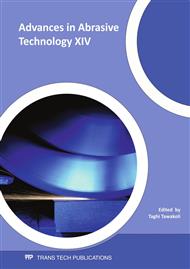p.606
p.621
p.627
p.633
p.638
p.647
p.653
p.659
p.666
A Study of Jet Formation for Premixed Slurry Jet Nozzle Using the Discrete Phase Model
Abstract:
Abrasive jets can be used for polishing when fine slurry is used. This paper presents a model for the jet formation process, CFD simulations are carried out for the prediction of flow pattern in a nozzle with abrasive suspension slurry jets using the discrete phase model. The CFD model aids in understanding the process because of the difficulties in performing the direct measurement of the jet axial velocity and radial velocity, the model simulates the different pressure premixed slurry pass through the pipeline and the focus tube to the atmosphere. The model is able to predict the orifice efficiency and the cross sectional profiles of the jet velocity after the nozzle, the modeled results are in good agreement with both experimental and analytical data. The simulation model can be useful in studying the overall slurry jet process and for the optimization of the slurry jet parameters.
Info:
Periodical:
Pages:
638-644
Citation:
Online since:
August 2011
Authors:
Price:
Сopyright:
© 2011 Trans Tech Publications Ltd. All Rights Reserved
Share:
Citation:


